Stories from the field : Building Environmentally-Friendly Houses in the North of Sri Lanka Mr. Shahul Hameed Anees, Puthuweli Village, Mannar District
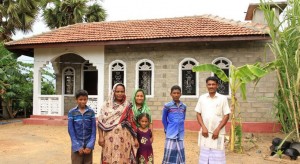 February 2015, Mannar, Sri Lanka. The “Improving Living Conditions in Returnee Areas of Sri Lanka through Housing” project is a housing recovery initiative supporting returning Internally Displaced Persons (IDP’s) in the North and East of Sri Lanka. Funded primarily through a Grant of € 11.8 million by the European Union (EU), it is built on the previous EU investment in reconstruction in housing through the North East Housing Reconstruction Programme (NEHRP) and the “Support to Conflict Affected People through Housing” project. Donor partners include the Australian Government (DFAT) and Swiss Agency for Development and Cooperation (SDC).
February 2015, Mannar, Sri Lanka. The “Improving Living Conditions in Returnee Areas of Sri Lanka through Housing” project is a housing recovery initiative supporting returning Internally Displaced Persons (IDP’s) in the North and East of Sri Lanka. Funded primarily through a Grant of € 11.8 million by the European Union (EU), it is built on the previous EU investment in reconstruction in housing through the North East Housing Reconstruction Programme (NEHRP) and the “Support to Conflict Affected People through Housing” project. Donor partners include the Australian Government (DFAT) and Swiss Agency for Development and Cooperation (SDC).
Jointly implemented by UN‐Habitat and SDC, the project provides cash grants and technical support to homeowners to reconstruct and repair conflict damaged houses in the districts of Mullaitivu, Killinochchi, Mannar and Batticaloa. Mr. Shahul Hameed Anees is a project beneficiary from Puthuweli Village in Mannar District who has constructed his house with a cash grant from the project. Mr.Anees’ new house is unique in that he has constructed a model “demonstration house” using environmentally friendly materials and techniques as part of UN-Habitat’s efforts towards promoting sustainable construction.
Forty three year old Anees earns his living as a farmer cultivating rice paddy and green chillies in two plots of land in Puthuweli village. He and his wife, Jarina Umma, live in their new home with their five children. Four of their children, two sons and two daughters, attend school at Musali National School. Their eldest son, having completed his GCE Advanced Level examination in 2014, is helping Anees with his agricultural activities.
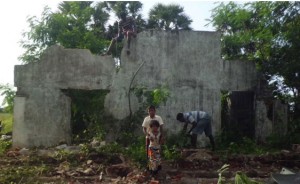 Anees, like thousands of others from Mannar district, was forced to leave his village in November 1990 when the LTTE ordered all families to vacate their homes within 36 hours. Displaced when he was just 19 years old, Anees, with his parents and ten siblings, moved to Kalpitiya in Puttalam district where they lived in IDP camps and temporary shelters for years. In July 1994, Anees married Ms. Jarina Umma and the couple continued to live in Kalpitiya for the next 16 years. With the end of the conflict in May 2009, an opportunity arose for internally displaced persons to return to their villages of origin. In August 2009, Anees returned to Puthuweli, where he found that much of the village infrastructure including his family home had been destroyed beyond repair. Keen to resettle in his village, Anees constructed a temporary shelter using tin sheets provided by the Government of Sri Lanka.
Anees, like thousands of others from Mannar district, was forced to leave his village in November 1990 when the LTTE ordered all families to vacate their homes within 36 hours. Displaced when he was just 19 years old, Anees, with his parents and ten siblings, moved to Kalpitiya in Puttalam district where they lived in IDP camps and temporary shelters for years. In July 1994, Anees married Ms. Jarina Umma and the couple continued to live in Kalpitiya for the next 16 years. With the end of the conflict in May 2009, an opportunity arose for internally displaced persons to return to their villages of origin. In August 2009, Anees returned to Puthuweli, where he found that much of the village infrastructure including his family home had been destroyed beyond repair. Keen to resettle in his village, Anees constructed a temporary shelter using tin sheets provided by the Government of Sri Lanka.
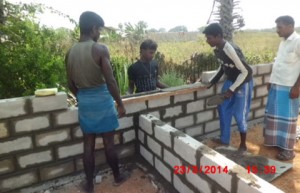 During this time, Anees opted to leave his family in Kalpitiya as the temporary shelter provided little space and he also did not want to disrupt the children’s education. As a farmer, earning an income of about LKR 12,500 per month, and with little savings of his own, Anees didn’t have sufficient funds to rebuild a permanent home. He also faced difficulties as the vision in his right eye was impaired due to an injury sustained during a bomb blast in 1990.
During this time, Anees opted to leave his family in Kalpitiya as the temporary shelter provided little space and he also did not want to disrupt the children’s education. As a farmer, earning an income of about LKR 12,500 per month, and with little savings of his own, Anees didn’t have sufficient funds to rebuild a permanent home. He also faced difficulties as the vision in his right eye was impaired due to an injury sustained during a bomb blast in 1990.
When the “Improving Living Conditions in Returnee Areas of Sri Lanka through Housing” project commenced in Puthuweli village, UN-Habitat conducted a needs assessment to identify families needing housing support. In October 2013, Anees was selected as a beneficiary to build his house. As he showed a keen interest in eco-friendly technologies, Anees was selected by UN-Habitat to build a “demonstration” house. The purpose of demonstration houses is to encourage potential homeowners to use cost-effective and environmentally friendly technologies in their housing reconstruction through practical demonstration of their many benefits.
As the housing project followed a “homeowner driven” process of reconstruction, Anees and his wife, Mrs.Jarina Umma, were in charge of the construction process with technical support from UN-Habitat Technical Officers and Engineers. They hired local skilled masons and carpenters while the family members provided unskilled labour support including clearing the construction site of debris, excavation of soil to lay the foundation and block making.
 Anees and Jarina had selected a house plan designed by UN-Habitat and modified it to suit the family’s specific needs. The plan differed from the standard house plans as it included an open, central courtyard as one of its main features. In keeping with the cultural norms of the Muslim community, the couple opted to build separate living rooms for males and females.
Anees and Jarina had selected a house plan designed by UN-Habitat and modified it to suit the family’s specific needs. The plan differed from the standard house plans as it included an open, central courtyard as one of its main features. In keeping with the cultural norms of the Muslim community, the couple opted to build separate living rooms for males and females.
Anees and his family completed constructing the house in July 2014, within a period of 9 months. As the soil in the area consisted of expansive clay, the house required a special concrete foundation. Anees was able to achieve a considerable cost saving by reusing the building debris from his old, damaged house. He had also used rubble and brick debris in building the foundation and in concreting the floor area.
Their new home has a verandah, two living rooms, a kitchen, two bedrooms, a bathroom and toilet. The bedrooms, sitting room and kitchen open out to the courtyard which gives the house extra light and ventilation. The kitchen is bright and airy as it gets sunlight from both the front garden as well as the courtyard. The courtyard is a useful space connecting the indoor and outdoor areas of the house. Amongst its many functions, it is used as a children’s play area and to dry the household grains and spices.
The house has been constructed using fair-faced cement blockwork for walls. Fair-faced blockwork is cost effective and eco-friendly as it reduces sand consumption for construction by approximately 25 percent. Several internal walls have been finished with mud plaster which gives the home a beautiful finish as well as coolness to the inhabitants.
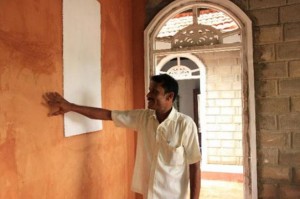 The roof has been constructed with clay tiles and coconut timber beams. In order to minimise the adverse impact on the forest cover and to save carpentry costs, Anees has used precast cement door and window frames. Their toilet and bathroom is attached to the main house and is accessible from the courtyard. A rainwater harvesting system has been installed on the roof slab of the toilet, providing fresh water for the family.
The roof has been constructed with clay tiles and coconut timber beams. In order to minimise the adverse impact on the forest cover and to save carpentry costs, Anees has used precast cement door and window frames. Their toilet and bathroom is attached to the main house and is accessible from the courtyard. A rainwater harvesting system has been installed on the roof slab of the toilet, providing fresh water for the family.
Anees had faced several challenges during construction, including difficulties in finding trained, skilled workers in fair-faced masonry and the escalating building material costs. UN-Habitat had assisted the family to overcome this difficulty by conducting training programmes for masons on fair-faced masonry at the house construction site.
Anees and Jarina are proud of their achievement in building a permanent home which is now benefiting the entire family. “It has been a long cherished dream to live with my family in a permanent home in our own village. This dream has finally been realised with help of the donors and UN-Habitat. We are grateful to the Divisional Secretary who helped to resolve timber and sand supply issues at village level. Our family is now safe from extreme weather conditions and we are no longer worried about the monsoon rains” Anees stated.
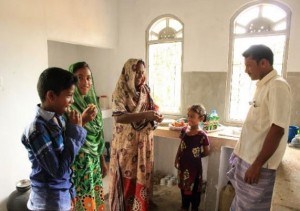 As Anees volunteers his time for community activities, he was selected as the President of the Puthuweli Village Rehabilitation Committee. The Puthuweli VRC is an active community organisation that assists many returnee families in the village to rebuild their homes. Having purchased block making machines with funding from the Government of Japan, the VRC is manufacturing cement blocks to construct walls. The VRC has produced and sold over 17,000 cement blocks, even providing vulnerable families the option of paying through several instalments.
As Anees volunteers his time for community activities, he was selected as the President of the Puthuweli Village Rehabilitation Committee. The Puthuweli VRC is an active community organisation that assists many returnee families in the village to rebuild their homes. Having purchased block making machines with funding from the Government of Japan, the VRC is manufacturing cement blocks to construct walls. The VRC has produced and sold over 17,000 cement blocks, even providing vulnerable families the option of paying through several instalments.
With the completion of his house, Anees is now concentrating on his livelihood activities. The family regularly host visitors who are interested in replicating the eco-friendly techniques and materials used in the house.
The Improving Living Conditions in Returnee Areas of Sri Lanka through Housing Project is being implemented from January 2013 to June 2015 in the districts of Killinochchi, Mullaitivu and Mannar in the North and Batticaloa in the East. The project will support the reconstruction of 4,600 houses and a number of infrastructure initiatives including 12 preschools, 14 community centres, 20 wells, and the rehabilitation of approximately 32 km of internal access roads.
